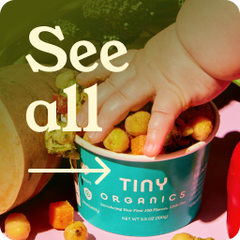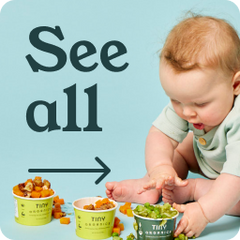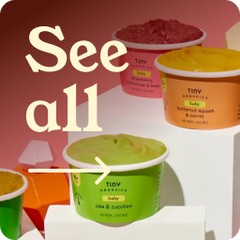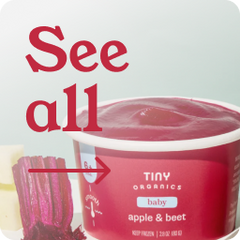When Do Babies Start Teething?

Most babies start teething at around six months old. Of course, every baby is different: some start before four months (some are even born with their first teeth!), and some don’t start until after 12 months.
As parents, we love the beautiful diversity of our babies … but it can also make parenting a little more difficult at times. Has your baby been extra fussy lately because they’re teething, or is it something else? Is your baby drooling and chewing more because of teething, or could it be something else?
Recognizing and soothing teething can be difficult, especially for first-time parents. Knowing what to look for and how to help will make it much easier on everyone.
7 Symptoms and Signs of Teething
Different babies handle teething differently. Some experience a lot of discomfort and pain, while others seem to be less bothered. Wherever your baby lands on the spectrum, here are a few symptoms of teething to watch for:
1. Lots of drool. Babies drool, but teething babies drool a lot. The excess drool might even lead to a teething rash—red, chapped, or sore skin on baby’s chin, mouth, or neck. Some will also experience a slight gag reflex and cough occasionally.
2. A flushed cheek or cheek-rubbing. This is more common with erupting molars. Soreness on one side of the mouth can become soreness in that cheek. The cheek may become red, and baby may rub or tug on it.
3. Ear-pulling. Also more common as your baby gets molars, some babies feel the pain of new teeth all the way back to the ear on the same side. (Note that many babies with ear infections also pull on their ears, so if you think it’s more than teething, consult your pediatrician.)
4. Red or swollen gums. Some teeth cut right through and others take longer. The latterlater, unfortunately, makes baby’s gums red, swollen, and tender.
5. Biting. The counterpressure of biting and chewing can help ease the discomfort of teeth trying to push through the gum line. Babies who are cutting teeth will usually try to gnaw on whatever they can get in their mouths.
6. Extra fussiness. Teething hurts and your baby doesn’t understand what’s happening, so they will protest. Teething doesn’t sleep, either, so even if your baby was sleeping through the night, they might wake up fussy while those teeth are pressing.
7. Food strikes. Suction is normally a soothing activity for babies, but it can make sore gums even more uncomfortable. Even babies who have started solid foods might be too fussy to cooperate with meal time. A hungry tummy will usually win out pretty quickly, but if the food strike lasts too long, call your pediatrician.
How to Ease Teething Pain
One of the worst feelings in the world (next to teething) is knowing your baby is in pain. Fortunately, there are some simple steps you can take to easy baby’s sore gums.
How Many Teeth Do Babies Get?
Starting from about six months old, until about three years old, children will get a full set of 20 baby (or “milk”) teeth. Around age five or six, these baby teeth will start to fall out, to make room for adult teeth.
What order do baby teeth come in?
Baby teeth tend to erupt according to a standard schedule. Here’s what you can expect:
- Lower incisors (bottom, front teeth)
- Upper incisors (top, front teeth)
- Upper lateral incisors (top, either side of the incisors)
- Lower lateral incisors (bottom, either side of the incisors)
- First molars (upper then lower, closest to the front)
- Canines (between incisors and molars)
- Second molars (upper then lower, back molars)
When to Start Brushing Baby Teeth
It’s never too early to start brushing your baby’s teeth and gums.
Most pediatric dentists recommend cleaning a baby’s gums with a clean, damp washcloth or finger—or even a soft silicone finger brush—twice per day. This can prevent bacteria build-up and start your little one on healthy oral hygiene habits. Make sure one of those cleanings is before bed.
When those baby teeth start poking through, use the silicone finger brush or a baby toothbrush (with just a few rows of very soft bristles) to clean little chompers twice per day. You can use a very small dot of toothpaste, about the size of a grain of rice, if you want. You may want to position your little one to drool over the sink and encourage them to try spitting, but it’s okay if they swallow such a trace amount of toothpaste.
Happy Teething!
We all hope that our babies will be easy teethers, but it’s best to prepare just in case. Knowing how to recognize teething, and how to help sooth your little one, can make the whole process less painful for everyone!



















